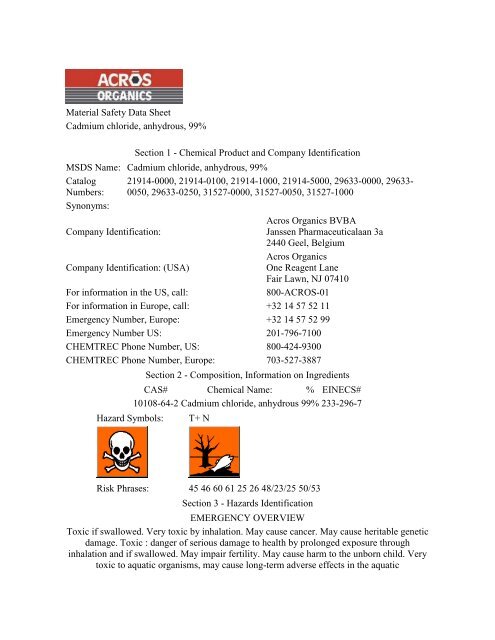MSDS Cadmium chloride
MSDS Cadmium chloride
MSDS Cadmium chloride
You also want an ePaper? Increase the reach of your titles
YUMPU automatically turns print PDFs into web optimized ePapers that Google loves.
Material Safety Data Sheet<br />
<strong>Cadmium</strong> <strong>chloride</strong>, anhydrous, 99%<br />
Section 1 - Chemical Product and Company Identification<br />
<strong>MSDS</strong> Name: <strong>Cadmium</strong> <strong>chloride</strong>, anhydrous, 99%<br />
Catalog 21914-0000, 21914-0100, 21914-1000, 21914-5000, 29633-0000, 29633-<br />
Numbers: 0050, 29633-0250, 31527-0000, 31527-0050, 31527-1000<br />
Synonyms:<br />
Acros Organics BVBA<br />
Company Identification:<br />
Janssen Pharmaceuticalaan 3a<br />
2440 Geel, Belgium<br />
Acros Organics<br />
Company Identification: (USA)<br />
One Reagent Lane<br />
Fair Lawn, NJ 07410<br />
For information in the US, call:<br />
800-ACROS-01<br />
For information in Europe, call: +32 14 57 52 11<br />
Emergency Number, Europe: +32 14 57 52 99<br />
Emergency Number US: 201-796-7100<br />
CHEMTREC Phone Number, US: 800-424-9300<br />
CHEMTREC Phone Number, Europe: 703-527-3887<br />
Hazard Symbols:<br />
Section 2 - Composition, Information on Ingredients<br />
CAS# Chemical Name: % EINECS#<br />
10108-64-2 <strong>Cadmium</strong> <strong>chloride</strong>, anhydrous 99% 233-296-7<br />
T+ N<br />
Risk Phrases: 45 46 60 61 25 26 48/23/25 50/53<br />
Section 3 - Hazards Identification<br />
EMERGENCY OVERVIEW<br />
Toxic if swallowed. Very toxic by inhalation. May cause cancer. May cause heritable genetic<br />
damage. Toxic : danger of serious damage to health by prolonged exposure through<br />
inhalation and if swallowed. May impair fertility. May cause harm to the unborn child. Very<br />
toxic to aquatic organisms, may cause long-term adverse effects in the aquatic
environment.Hygroscopic (absorbs moisture from the air).<br />
Potential Health Effects<br />
Eye: May cause eye irritation.<br />
Skin: May cause skin irritation. May be harmful if absorbed through the skin.<br />
May cause gastrointestinal irritation with nausea, vomiting and diarrhea. Toxic if<br />
Ingestion:<br />
swallowed.<br />
May be fatal if inhaled. Causes respiratory tract irritation. May cause severe<br />
Inhalation: irritation of the respiratory tract with sore throat, coughing, shortness of breath<br />
and delayed lung edema.<br />
May cause respiratory tract cancer. May cause liver and kidney damage. Chronic<br />
Chronic: inhalation may cause nasal septum ulceration and perforation. May cause cancer<br />
in humans.<br />
Eyes:<br />
Skin:<br />
Ingestion:<br />
Inhalation:<br />
Notes to<br />
Physician:<br />
General<br />
Information:<br />
Extinguishing<br />
Media:<br />
General<br />
Information:<br />
Spills/Leaks:<br />
Section 4 - First Aid Measures<br />
Immediately flush eyes with plenty of water for at least 15 minutes,<br />
occasionally lifting the upper and lower eyelids. Get medical aid immediately.<br />
Get medical aid immediately. Flush skin with plenty of water for at least 15<br />
minutes while removing contaminated clothing and shoes.<br />
Get medical aid immediately. Wash mouth out with water.<br />
Get medical aid immediately. Remove from exposure and move to fresh air<br />
immediately. If not breathing, give artificial respiration. If breathing is<br />
difficult, give oxygen.<br />
Section 5 - Fire Fighting Measures<br />
As in any fire, wear a self-contained breathing apparatus in pressuredemand,<br />
MSHA/NIOSH (approved or equivalent), and full protective gear.<br />
Substance is noncombustible.<br />
Use extinguishing media most appropriate for the surrounding fire.<br />
Section 6 - Accidental Release Measures<br />
Use proper personal protective equipment as indicated in Section 8.<br />
Vacuum or sweep up material and place into a suitable disposal container.<br />
Wear a self contained breathing apparatus and appropriate personal<br />
protection. (See Exposure Controls, Personal Protection section). Avoid<br />
generating dusty conditions. Remove all sources of ignition.<br />
Section 7 - Handling and Storage<br />
Use with adequate ventilation. Minimize dust generation and accumulation. Keep<br />
Handling: away from heat, sparks and flame. Do not get on skin or in eyes. Do not ingest or<br />
inhale. Use only in a chemical fume hood.<br />
Storage: Keep away from sources of ignition. Store in a cool, dry place. Do not store in
direct sunlight. Store in a tightly closed container. Keep under a nitrogen blanket.<br />
Section 8 - Exposure Controls, Personal Protection<br />
Engineering Controls:<br />
Use adequate ventilation to keep airborne concentrations low.<br />
Exposure Limits<br />
CAS# 10108-64-2:<br />
United Kingdom, WEL - TWA: ( cadmium compounds): 0.025<br />
mg/m3 TWA (except cadmium oxide fume, cadmium sulphide,<br />
cadmium sulphide p United Kingdom, WEL - STEL: ( cadmium<br />
compounds): 0.075 mg/m3 STEL (except cadmium oxide fume,<br />
cadmium sulphide, cadmium sulphide<br />
United States OSHA: 2.5 æg/m3 Action Level (as Cd); 5 æg/m3<br />
PEL (as Cd. Do not eat, drink or chew t obacco or gum or apply<br />
cosmetics in regulated areas. Carcinogen: dust can cause lung and<br />
kidney disease. See 29 CFR 1910.1027) (<strong>Cadmium</strong> compounds).<br />
Belgium - TWA: ( cadmium compounds): 0.002 mg/m3 VLE<br />
(respirable particulates, as Cd); 0.01 mg/m3 VLE (inhalable part<br />
France - VME: ( cadmium compounds): 0.05 mg/m3 VME (as Cd)<br />
Germany: ( cadmium compounds): 0.05 mg/m3 VME (as Cd)<br />
Japan: ( cadmium compounds): 0.05 mg/m3 OEL (as Cd)<br />
Malaysia: ( cadmium compounds): 0.01 mg/m3 TWA (as Cd);<br />
0.002 mg/m3 TWA (respirable fraction, as Cd)<br />
Spain: 0.01 mg/m3 VLA-ED (inhalable fraction, as Cd); 0.002<br />
mg/m3 VLA-ED (respirable fr<br />
Personal Protective Equipment<br />
Eyes: Wear chemical splash goggles.<br />
Skin: Wear impervious gloves.<br />
Clothing: Wear appropriate protective clothing to prevent skin exposure.<br />
Follow the OSHA respirator regulations found in 29 CFR 1910.134 or European<br />
Standard EN 149. Use a NIOSH/MSHA or European Standard EN 149<br />
Respirators: approved respirator if exposure limits are exceeded or if irritation or other<br />
symptoms are experienced.<br />
Section 9 - Physical and Chemical Properties<br />
Physical State: Powder<br />
Color: white<br />
Odor: Not available
Chemical Stability:<br />
Conditions to Avoid:<br />
Incompatibilities with Other<br />
Materials<br />
Hazardous Decomposition<br />
Products<br />
Hazardous Polymerization<br />
RTECS#:<br />
pH: Not available<br />
Vapor Pressure: 13mbar @656 deg C<br />
Viscosity: Not available<br />
Boiling Point: 960 deg C @760mmHg ( 1,760.00°F)<br />
Freezing/Melting Point: 568 deg C ( 1,054.40°F)<br />
Autoignition Temperature: Not available<br />
Flash Point: Not available<br />
Explosion Limits: Lower: Not available<br />
Explosion Limits: Upper: Not available<br />
Decomposition Temperature: Not available<br />
Solubility in water: 1400 g/l water (20°C)<br />
Specific Gravity/Density:<br />
Molecular Formula: CdCl2<br />
Molecular Weight: 183.31<br />
Section 10 - Stability and Reactivity<br />
Stable at room temperature in closed containers under normal<br />
storage and handling conditions.<br />
Incompatible materials, dust generation, exposure to moist air<br />
or water.<br />
Oxidizing agents, active metals, aluminum, bromine<br />
trifluoride, zinc, potassium.<br />
<strong>Cadmium</strong> fumes, <strong>chloride</strong> fumes.<br />
Has not been reported.<br />
Section 11 - Toxicological Information<br />
CAS# 10108-64-2: EV0175000<br />
LD50/LC50:<br />
RTECS:<br />
CAS# 10108-64-2: Oral, mouse: LD50 = 60 mg/kg;<br />
Oral, mouse: LD50 = 3.3 mg/kg;<br />
Oral, rat: LD50 = 88 mg/kg;<br />
.<br />
Carcinogenicity:<br />
<strong>Cadmium</strong> <strong>chloride</strong>, anhydrous - California: carcinogen, initial date 10/1/87<br />
(<strong>Cadmium</strong> compounds). NTP: Known carcinogen (<strong>Cadmium</strong> compounds).<br />
IARC: Group 1 carcinogen<br />
Other:<br />
See actual entry in RTECS for complete information. Possible mutagen.<br />
Possible teratogen.<br />
Section 12 - Ecological Information
Not available<br />
Section 13 - Disposal Considerations<br />
Dispose of in a manner consistent with federal, state, and local regulations.<br />
Shipping<br />
Name:<br />
Hazard<br />
Class:<br />
UN<br />
Number:<br />
Packing<br />
Group:<br />
Section 14 - Transport Information<br />
IATA IMO RID/ADR<br />
CADMIUM<br />
CADMIUM CADMIUM<br />
COMPOUND(forbidden to ship via<br />
COMPOUND COMPOUND<br />
passenger air)<br />
6.1 6.1 6.1<br />
2570 2570 2570<br />
I I I<br />
USA RQ: CAS# 10108-64-2: 10 lb final RQ; 4.54 kg final RQ<br />
Severe Marine Pollutant<br />
European/International Regulations<br />
Section 15 - Regulatory Information<br />
European Labeling in Accordance with EC Directives<br />
Hazard Symbols: T+ N<br />
Risk Phrases:<br />
R 45 May cause cancer.<br />
R 46 May cause heritable genetic damage.<br />
R 61 May cause harm to the unborn child.<br />
R 25 Toxic if swallowed.<br />
R 26 Very toxic by inhalation.<br />
R 48/23/25 Toxic : danger of serious damage to health by prolonged exposure<br />
through inhalation and if swallowed.<br />
R 50/53 Very toxic to aquatic organisms, may cause long-term adverse effects<br />
in the aquatic environment.<br />
R 60 May impair fertility.<br />
Safety Phrases:<br />
S 53 Avoid exposure - obtain special instructions before use.<br />
S 45 In case of accident or if you feel unwell, seek medical advice immediately<br />
(show the label where possible).<br />
S 60 This material and its container must be disposed of as hazardous waste.<br />
S 61 Avoid release to the environment. Refer to special instructions/safety data<br />
sheets.<br />
WGK (Water Danger/Protection)
CAS# 10108-64-2: Not available<br />
Canada<br />
CAS# 10108-64-2 is listed on Canada's DSL List<br />
<br />
US Federal<br />
TSCA<br />
CAS# 10108-64-2 is listed on the TSCA Inventory.<br />
Section 16 - Other Information<br />
<strong>MSDS</strong> Creation Date: 7/16/1996<br />
Revision #2 Date 2/18/2004<br />
Revisions were made in Sections: General revision.<br />
The information above is believed to be accurate and represents the best<br />
information currently available to us. However, we make no warranty of<br />
merchantibility or any other warranty, express or implied, with respect to<br />
such information, and we assume no liability resulting from its use. Users<br />
should make their own investigations to determine the suitability of the<br />
information for their particular purposes. In no event shall the company be<br />
liable for any claims, losses, or damages of any third party or for lost profits<br />
or any special, indirect, incidental, consequential, or exemplary damages<br />
howsoever arising, even if the company has been advised of the possibility of<br />
such damages.<br />
--------------------------------------------------------------------------------



